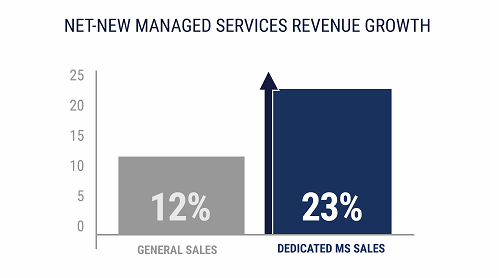3 Managed Services Mistakes To Avoid
By George Humphrey, VP Research and Advisory, Managed Services, TSIA

Managed services continues to be one of the fastest-growing segments of the technology services industry, but is not without its challenges. Time and again, I see the same mistakes being made over and over. In an effort to offer solutions to some common problems, here’s a guide for avoiding the typical pitfalls companies might encounter on the road to establishing a successful managed services business.
Mistake #1: Lack of Understanding
It sounds simple enough, and could almost seem insulting to some executives. However, there is a gross misunderstanding of managed services at the most fundamental levels at many organizations.
Managed services not only oversees the operation of IT infrastructure and application, but also the consumption of technology. There’s a dual focus on the purpose of the technology and the business problem it solves. However, managed services is the only service line that isn’t sold as “attached” to the product sale. In fact, it’s often sold prior to or at the same time as the product sale.
This separation between transactions means managed services is very different from other service lines embedded in product companies, and not appreciating this difference can lead to mistake #1.
To avoid making this mistake, you must establish a service development process that thoroughly explores your customer’s challenges. Once you’ve done that you can tailor your managed services business around removing those pain points one by one. Here are 5 different types of offerings that fall under the umbrella of managed services that will help meet your customer’s needs:
- Monitor: Performing technology monitoring services and assisting customers as questions crop up.
- Operate: After monitoring and notification services, a customer might transfer the operation of a solution to a third party. The customer still owns the technology, but rather someone else to manage it for them.
- Optimize: Once a solution is up and running, a managed service provider (MSP) can help improve the overall performance of solutions through optimization.
- Transform: Helping a customer make the transition from legacy platforms, or older solutions, to next generation solutions, as well as operating them on their behalf.
- Managed XaaS/Cloud: In this solution, the MSP does everything for the customer, including offering network infrastructure collaboration-as-a-service.

Mistake #2: Portfolio Confusion
Though managed services are not new to the technology industry, the Technology Service Industry Association (TSIA) has seen a radical transformation of managed services and the way they’re delivered over the past 5-7 years. As an industry, there’s a dramatic shift as services become more important than products, and support services are steadily increasing in value. And while service line revenues are definitely on the rise, managed services is growing faster than any other, accounting for 23% of total services revenue.

Source: 2017 TSIA Managed Services Benchmark Study
More and more companies are beginning to include additional VAS (value-added services) on top of their maintenance offers, and there’s a common overlap between support services and managed services. However, when purchasing a managed services agreement, the customer wants the provider to own the complex IT operations, not provide assistance. In short, customers are looking for an agreement to support an entire solution end-to-end, and want their MSP to enable innovation while providing peace of mind.
Ensure your offer strategy isn’t sending mixed messages by reviewing it today:
- Is there clear delineation between your managed services offers and your support/advanced offers?
- Can the difference in your value propositions be clearly articulated?
Analogy
If a support offer were ice cream, your customers wouldn’t think of managed services as the sprinkles on the top, they’d expect it to be the whole sundae.
Mistake #3: Sales Disconnect
Although there may be a strong desire to leverage your existing sales team to sell managed services, it’s an entirely different animal and requires its own dedicated team.
Selling managed services requires a superset of skills to sell the combined value of technology, professional, support, and operational functions, as well as a deep understanding of the relationship between business problems and technology.
Furthermore, most of these purchasing decisions are made at the highest level of the company -- not by the IT director or even the vice president of IT operations -- but at the CXO level. Therefore, the skills and ability to have candid, relationship-based conversations with the CXO level of a company are necessary, and often hard to come by in many salespeople.
So, what to do? Start by recognizing that selling managed services is not a skill that most general sales organizations possess, and stand up either a dedicated managed services sales team, or at a minimum, an overlay managed services specialist team. Then, by leveraging your general, services, or annuity sales teams to assist in initial qualification, you can have them filter out the glaringly obvious unqualified opportunities and work with your managed services sales experts to build the relationships, consult with the client, and close the deal.

Source: 2017 TSIA Managed Services Benchmark Study
Conclusion
While making any of these mistakes can cause irreparable damage to the long-term health and sustainability of your managed services business, there is hope! It’s simply a matter of identifying problem areas early and knowing how to fix them. Once your managed services business is thriving, the rewards will be well worth the dollars and the patience invested. If properly executed, managed services is “the gift that keeps on giving,” resulting in higher customer retention rates and client satisfaction.
 George Humphrey is the vice president of managed services research for the Technology Services Industry Association (TSIA). He has over 25 years of experience in the networking and communications industry, specializing in managed infrastructure and applications services. In his role at TSIA, George provides members with fact-based education and insight into the performance and operations of managed services providers of all sizes.
George Humphrey is the vice president of managed services research for the Technology Services Industry Association (TSIA). He has over 25 years of experience in the networking and communications industry, specializing in managed infrastructure and applications services. In his role at TSIA, George provides members with fact-based education and insight into the performance and operations of managed services providers of all sizes.
Throughout his career, George has held leadership roles in managed services product management, client management, tools and architecture development, delivery operations, process definition, and global strategy. Prior to TSIA, George worked for Avaya, where he was recognized as one of their most successful product managers as well as one of their top four thought leaders for the communications and networking industry. In this position, he led the strategy and development of Avaya's managed services business, which was their fastest-growing line of business four years in a row.
George frequently shares his insight and first-hand experiences through various publications, such as white papers, research reports, blogs, as well as ebooks, on topics designed to help managed services providers understand their strengths, weaknesses, and core areas of opportunity. He regularly participates in public speaking engagements worldwide. Leveraging the latest industry research, best practices, and his own expertise, George aims to provide a fundamental understanding of what it means to be a successful managed services organization
